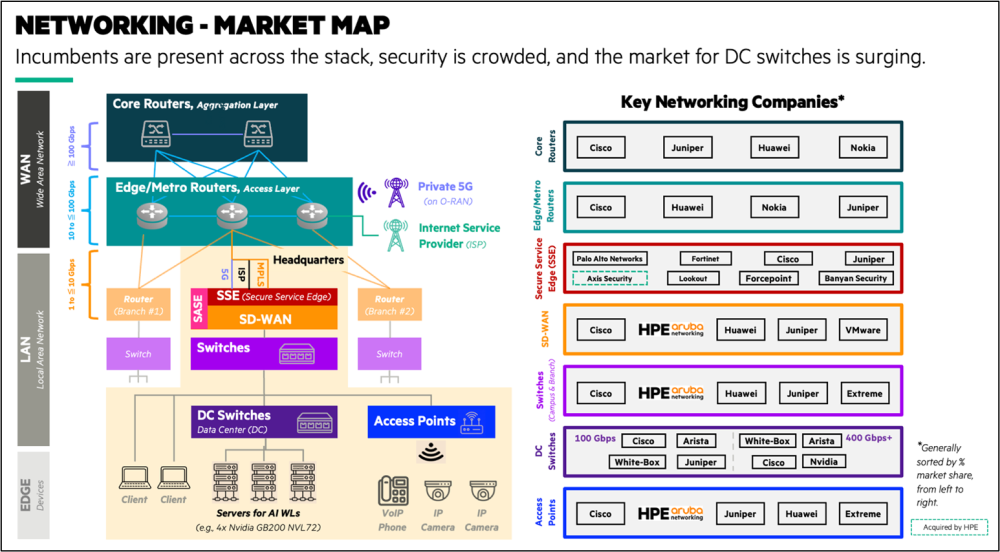Authored by Shawn Ranjbaran, Principal and Ali Wasti, Senior Managing Director, Hewlett Packard Pathfinder

Enterprises and society at large depend on networking technology for everything from sending email, to streaming Netflix, to utilizing AI copilots. In particular, the growing adoption of Generative AI (Gen AI) applications, such as ChatGPT, has fueled unprecedented demand for higher performing networking infrastructure in back-end AI data centers that deliver such applications. This, in turn, has driven enterprises to invest in bleeding-edge networking solutions to remain competitive. Although fundamental networking components have existed for decades, innovation is happening in pockets across the sector. This article provides Pathfinder’s overview of the different networking components and market dynamics.
Networking technology encompasses the hardware, software, and communication protocols that enable resource-sharing and the interconnection of data between computers and other digital devices separated by a few inches to several miles. At a high-level, the three domains of modern networking architecture include Wide Area Networks (WANs), Local Area Networks (LANs), and edge devices, each serving distinct purposes. WANs connect geographically dispersed networks over long distances by core routers at the aggregation layer. LANs are designed for more localized communication, typically within a building or campus. Lastly, “the edge” represents the interface where end devices access public or private networks, such as coffee shop Wi-Fi or a corporate intranet, respectively. Each is shown in the Networking Market Map below, along the left-hand side.

Networking Components: Understanding the function and interplay of the components above.
• Routers & Gateways: Devices that connect multiple networks using Internet Protocol (IP) addresses. Core routers form the network’s backbone by connecting to edge/metro routers at high-speeds (>100 Gbps). Both edge and metro routers prioritize security and management capabilities over speed but are still relatively fast, at 10 – 100 Gbps. Distinguishing between the two, edge routers operate at the perimeter, connecting internal to external networks (e.g., Internet, partner networks), while metro routers connect LANs within a metropolitan area, carrier facilities, or points of presence (PoPs).
• Security Software: Software-defined WAN (SD-WAN) is router-deployed software that enables the dynamic routing of network traffic across multiple transport links (e.g., MPLS, broadband, 4G/5G), to improve application performance and network resilience. Secure Service Edge (SSE) is an integrated combination of security tools including a secure web gateway (SWG), cloud access security broker (CASB), Zero-Trust Network Access (ZTNA) provider, and software firewall. Secure Access Service Edge (SASE), a networking and security framework formed by the combination of SD-WAN and SSE, can provide authorized & authenticated access for end users and machine-to-machine communication, regardless of location or device.
• Switches: Networking devices that connect one device to many, enabling the flow of data across devices in a LAN using Media Access Control (MAC) addresses. Three main types exist:
Campus & Branch switches typically provide < 10 Gbps per port, utilize Ethernet, and support daily operations.
Data Center (DC) switches usually operate between 100 – 800 Gbps per port and are prevalent in environments where high-speed, low-latency networking is critical. The lower end of the throughput range is typically represented by Top-of-Rack (ToR) or End-of-Rack (EoR) switches that connect servers within a rack, whereas the higher end is represented by spine/leaf switches, which are commonly used in high-performance back-end AI data centers. While DC switches are predominantly Ethernet-based, Nvidia’s InfiniBand technology, known for its superior data speed and capabilities, is aggressively competing for market share.
White-box switches are modular, customizable switches consisting of standard, vendor-agnostic components.
• Access Points: Devices that facilitate and extend wireless communication (i.e., Wi-Fi 6) to provide seamless access to end devices on a LAN, thus enabling wireless LAN (i.e., WLAN).
As the market map indicates, the networking landscape is mostly an oligopoly of large vendors. Major players with broad portfolios, including Cisco, Juniper Networks, Huawei, and HPE, dominate the key components. One exception to this is the SSE layer, which consists of multiple startups as well as large enterprises; prominent examples include Palo Alto Networks, Fortinet, Forcepoint, and HPE’s Axis Security. Notably, HPE’s SSE and SD-WAN solutions, in tandem, allow it to deliver integrated AI-driven SASE solutions. As mentioned earlier, the DC switch market, is another rapidly evolving area, as companies such as Nvidia and Arista push past existing speeds to develop solutions capable of >400 Gbps per port, primarily to support back-end AI workloads. Additionally, white-box switches are ramping in popularity owing to their flexibility. Lastly, the opportunity for access points, a critical component of modern networks, is immense; market leaders include Cisco, Huawei, and HPE, whose product roadmap and company-level plans could substantively enhance its networking offerings in the coming years.
Pathfinder will continue to track networking technology as a thematic area of focus. If you’re a startup founder developing in related fields and this resonates with you, please reach out to us!
If you like this article consider subscribing to our bi-monthly newsletter to get information about our portfolio, solutions, and insights delivered to your inbox.